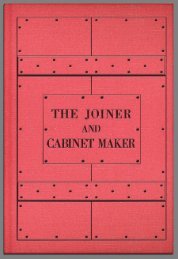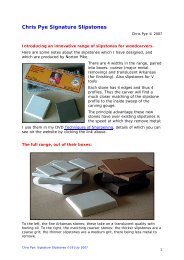WORK: Vol.1-No.51 - Tools for Working Wood
WORK: Vol.1-No.51 - Tools for Working Wood
WORK: Vol.1-No.51 - Tools for Working Wood
You also want an ePaper? Increase the reach of your titles
YUMPU automatically turns print PDFs into web optimized ePapers that Google loves.
' •' Ir8o6•SIGN-WRITING AND LETTERIA'G. [Work- Jiarcb 8, 1890,•Those are all the important tools that arereally required, but a variety of sable, camel'shair,hog's-hair, and " skewing '' brushes willcome into request in actual practice. Somepowdered chalk must be tied up securely in apiece of fine muslin to make a pounce bag<strong>for</strong> dusting on the painted surface. Sponges,dusters, and other requisites should be keptspecially <strong>for</strong> this work, and the whole ofthe tools and mat.erials are best kept in acompact tin box. .The materials u sed <strong>for</strong> gilding, or <strong>for</strong> theimitation of solid gold, are-1, genuine goldleaf; 2~ adHlterative ditto; 3, Dutch metal;and 4, oronze powders.In genuine gold leaf, there is a.lways acertain amount of alloy, as pure g6ld is tooductile to be worked bet,•een the goldbeater's skin without it. It is sold in b ooks,()f twenty-five leaves at about Is. 4d. each, and;gilders' work is measured and estimated by· t.he "hundred" (leaves). Gold leaf must be.kept in a dry place ; if allowed to get damp,-i t will be impossible to remove it from the· .. book without tearing it to pieces. Dampha.~ also the power of tc'l.mishing the leaf,• o.nd if any is discovered in this condition, it. "houlcl never be u sed or it will spoil the· work.Gold leaf should fall freely from the book. "On to the cushion by a gentle breath fromtbe operator ; if it does not do so it is damp,. aud !\hould, there<strong>for</strong>e, be placed in front ofa fire <strong>for</strong> an hour or so to dry it. Thereare three shades of gold leaf sold- 1, verypale : 2, medium or yellow · and 3, deepgold. No. 2 is the best <strong>for</strong> the sign-writer;it looks the best when varnished, and is theiuost durable if left un varnished. It also. ~tand s the best against atmospheric intl.uenceswhen used on outside work, which,. of course, comprises sign-writing.U pon inquiry, I find that Messrs. Brodieand Middleton sell a ''half gold" leaf atud. per book, which appears t o be a. very. good article <strong>for</strong> the pr1ce charged. It istuuch thicker than ordinary gold leaf, andi:i, there<strong>for</strong>e, easier <strong>for</strong> the novice to apply,.. a nd it wears quite as long n.s the more·-.expensive article. The same firm alsomake a special writer's gold size, which isvery pale and clear, and of excellent. qufl.l ity.There is now a cheap <strong>for</strong>m of _gold leaf'Upon the market known as the Venetia.nDucat Gold L eaf, and sold at 7s. 6d. per· thousand; it requires, I think, a. special oil. !lize and enamel, the latter being required<strong>for</strong> coating it after it has been applied to the-urfal!e to be gilded. It is then claimed to.be permanent and was hable, but although I:have never seen a sample, I am inclined to-the belief that, after all, it mny be only ail1etter sample of Dutch metal. It is madeand sold by T. Pavitt and Sons, 70, SouthamptonRow, W.C. Dutch metal is alllixt,lre of copper, brass, etc., and is madecm t!.s Continent. It is largely used intla ~a lres <strong>for</strong> pantomime and burlesque~'~'·: ncry, l1ence the writer's acquaintancewitll it is pretty extensive. It is also usedfr1r $!il din~ Christmas articles, and any kindof dtN\p and t emporary work. It may beU!ied by sign-writers and others <strong>for</strong> anytemporary purpose, but soon turns blackunless protected with a coat of patent knotting. Gold bron.ze powder may also bemixed with this, and applied to any smface,and will stand <strong>for</strong> years without tarnishingor _getting di¥loloured.Dutch metal is Hd. per book at any largeLondon colour wareliouse or thea tricn.l store. Inow come to & somewhat modern article ofconvenience~ I mean "tranafer gold leaf.''••...This is a perfect godsend to the sign-writerwhen 'vorking out of doors in windyweather. It is prepared as follows :Procure a. sh eet of strong white tissue paperand three pennyworth of white wax, lay thepaper upon a drawing board, and rub 1t allover-on one side only-with the wax.This must be well done, so that no smallportions of the paper are missed; this canbe ascertained by holding the paper sidewaysto the light, when t he waxed surfaceshould have a. glossy and even appearance.The paper is now cut up into squares a sizelarger than the leaves of gold ; the wax sideof the paper will now have a slight amountof t ackmess by which we a re able to transferthe gold leaf by adhesion. The book is carefullyopened ~ and a piece of wax paper islaid upon tne gold and slightly presseddown with the hand, and this is continuedr ight through the book until all t he leaveshave been provided with a sheet of waxedpaper. The book should now be placedunder some gentle pressure and it is ready<strong>for</strong> use. The method of using it will bedescribed further on in this paper.Letters <strong>for</strong> gilding are wntten in oil goldsize, procurable at any colour shop. Thereis a. slow and a. ~u ick size; the <strong>for</strong>m er is preparedby grindmg up fat hnseed oil andyellow ochre; <strong>for</strong> a quick gold size, a quickdryingvarnish with a little oil gold sizeadded to it to keep it tacky is a. goodpreparation. ·By regulating the quantity of oil put withthe varnish, the mordant may be made todry in three or four hours. Japanners' goldsize and pictnre-frame-gilders' size may alsobe u sed <strong>for</strong> lettering.Having enumerated the few necessariesrequired <strong>for</strong> letter gilding, I will now takethe student through. the process of writingand gilding a sign in simple unshaded letterson a. black ground. The first thing to do ist o so prepare the painted surface of the sign,that the leaf will be prevented from stickinganywhere except upon the sized portion, i.e.,the letters.A sign which is to contain gilded letterswhich are afterwards to be varnished, isalways given a coat of " flatting" as afinishing coat, and on this surface there isnot much chance of the gold adhering anywhereexcept upon the letters themsch·es.If the edges are not sharp and clea.r, however,the si~ just round the letters must be"egg-sized.' ·But there are a great manypeople who will not have their gilded lettersvarnished over, as it takes so much oft' thebrilliancy and richness of the gold, and inthis respect I concur with such people. I nsuch case, the sign has to be painted,varnish ed, and finished in every way be<strong>for</strong>ethe letters are put on, and so we have to becareful how we work, or we shall spoil our ownwork and other people's too. The 'l'arnish,which should be of the best and hardestdrying quality procurable, should be allowedto set quite bard ; it can \"'ery 'lvell be left<strong>for</strong> a week after being applied to the sign.' Yhen hard, we commence by removinaevery trace of dust and sponging the boa r~over with cold water ; this will r emove acertain amount of greasiness from thevarnish ; when dry, again dust, set out theletters in pencil, not in pipe clay, and thendust round with the pounce bag containingthe powdered chalk. This need not be doneto any unnecessary extent, as one frequentlysees to be the case, but should be carefullyapplied to t he spaces between the lettersland <strong>for</strong> an inch or two top and bottom otthe letters. I need hardly say that thischalk is to prevent the gold from stickingThe Work Magazine Reprint Project (-) 2012 tools<strong>for</strong>workingwood.com•anywhere bnt to the letters, and gi v i n~ . tothe same a. sharp, clear edge. A very shghtdusting should be sufficieut, and it mw'lt notobliterate the outline of the lettel's. ~houlrlnny chalk grit get upon the letters, it tnulitbe carefully du:sted off with a small brushbe<strong>for</strong>e applying the size, which we are nowto get into a workable state. The oil goldsize sold in t he little jars by oil and colourmenis generally too thick <strong>for</strong> use, and,there<strong>for</strong>e, requires t hinning t o the properconsistency. Drodie and Middleton sell itboth " thick " and " ready <strong>for</strong> use." Takingas much as we req_uire <strong>for</strong> immediate usefrom the jar, we tbtn it do}Vn with a littleboiled linseed oil, a nd ~train through a finepiece of muslin into a small jar <strong>for</strong> use. Theslow-drying size is laid on one day and giltthe next, but if we require to apply the goldlea.f on the same day as the size is applied,then we must use one of the quick-dryingmordants already mentioned. 'The method of pouncing the sign withchalk is a somewhat dirty and untidymethod of working, n.lthough it is the onein general use ; many of our hest writers,however, use instead, egg-size, which isprepared in this way :- A nice fresh egg ispricked at both ends with a large pin, andthe white of the egg only is blown into acup ; this is diluted with a. little water, andthe whole whisked up into a froth Wlth aclean new sash tool. This is now applied tothe sign and well worked over the entiresurface, and if properly done, will preventthe stray particles of gold from stickingu pon any part of the board. After thegilding is completed, t he egg-size is washedoff with a sponge and warm water.Having thus prepared our sign and goldsize, and marked the letters out, we take asuitable sable pencil and line and fill themin with the size, and Jea...-e it to get nearlydry. The great point now t o be decidedupon is, when is the size ready to take theleaf. This is somewhat difficult <strong>for</strong> thenoYice to decide. In the first place, if it istoo moist and tacky, the gold will sink rightinto the size, and lose all its brilliancy,besides showing every joint and lookingdirty in places. Secondly, if it has got toohard, it has lost most of its tackiness, andthere is not sufficient left to cause the goldto adhere properly. The beginner generallyfails from the first cause, but he is just asliable to err in the opposite direction if heallows too long an interval to elapse betweenbrushing on the size and applying the goldleaf. The state of the atmosphere has, ofcourse, a lot to do with the drying, andthe drying qualities of the size vary ina great degree ; so, as no two cases arealike as rerrards time of drying, a sharpeye must aiways be kept upon the work.I cannot ~ive more explicit directions,beyond saymg that a very slight tack~nesswill cause the gold to adhere, and thisis a.ll that is required.Taking <strong>for</strong> granted that t he size is nowright, we proceed to apply the leaf, and ~many signs are fainted and let.terGd IDthe shop, we wil first attempt the workindoors where no one can see our failures, ormake us ner vous by looking on. This is thetip and cushion process. Taking up thebook of gold leo.f, we open the first leaf, an~breathing very gently at the edge of. the leaf, .a.nd holdinrr the book at the same tlrue closedo,vn to t he cushion, we cause the leaf .tofall upon it. About four leaves are qu1tesufficient <strong>for</strong> the novice to take out at once,as he will be sure to waste the lot, and a fe":;books besides, unless he has an •:old ha~dbeside him to give him personal instrnchoL.,•













